Coffee Consumption Statistics by Country, Per Capita, & More – How the World Drinks Coffee (2024 Report)
Have you ever wondered: How much coffee does the world really consume?
I have, so I set out to analyze as many statistics on the topic as I could find. The results are interesting and staggering, and I want to share them with you in this article. You’ll find the stats on the countries that consumed the most amount of coffee, their per capita drinking habits, and more interesting coffee consumption statistics.
If you’re intrigued, take your coffee break and get ready to immerse yourself in the global culture of coffee.
The Place of Coffee in The World: Coffee on a Global Scale
The buzz around coffee is real and the statistics are fascinating. Data from the 2022/23 harvests show that over 168.2 million bags of coffee were produced globally (each bag weighs 60 kilograms). This is a slight 0.1% increase over the previous year, which actually had quite a drop, removing about 7 million bags from what was recorded in the previous year.

Speaking in cups, the world drinks a staggering average of approximately 400 billion cups of coffee annually, making it the world’s second most consumed drink, coming second to water.
The world drinks a staggering average of approximately 400 billion cups of coffee annually.
BigCupOfCoffee.com
Pretty impressive, right? This is why I take pride in being a barista and taking part in the preparation of such an impactful commodity in the world.
15 Top Coffee Consuming Countries
Here are the top 15 countries that consumed the highest amount of coffee beans as reported by the International Coffee Organization.
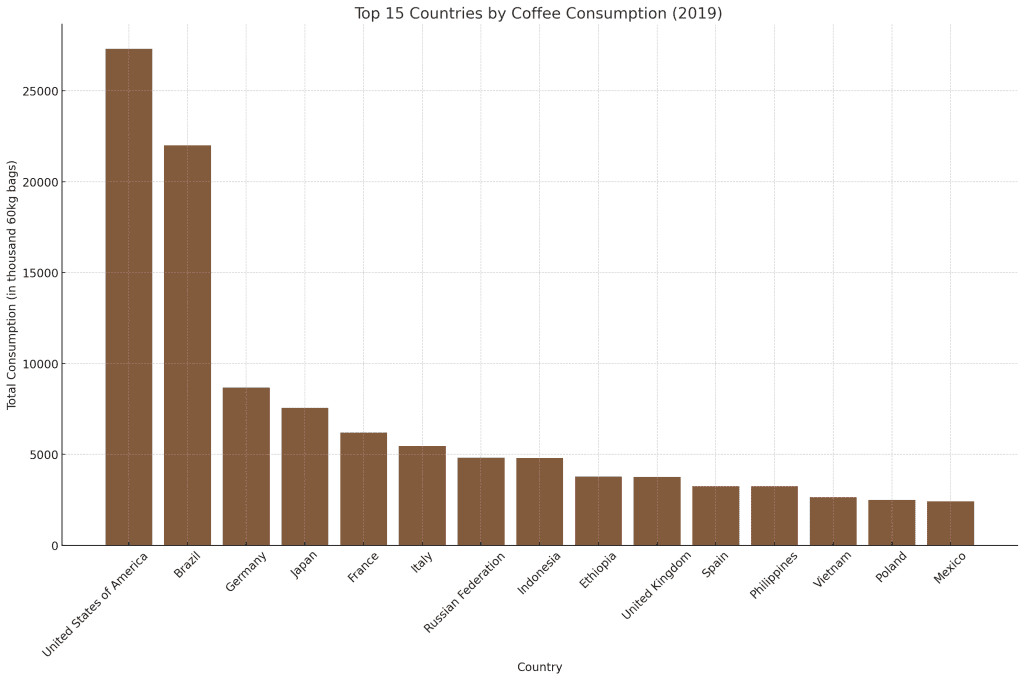
1. United States of America – Consumed 27,310 thousand 60kg bags
Fueled not only by the American dream but also by freshly brewed coffee, the USA is the world leader in drinking coffee. It claims the first spot with 27,310 thousand (27.3 million) 60kg bags of coffee beans.
With a population of 328.3 million as of 2019, America also ranks pretty high in consumption per person at 4.99kg per year, placing it sixth.
The USA also gets the top spot for having the world’s biggest coffee chain company, Starbucks, which now has 35,000 coffee houses around the globe.
2. Brazil – Consumed 22,000 thousand 60kg bags
On the second spot of the top coffee-consuming countries is Brazil— also the world’s biggest coffee producer. The amount of coffee that quenched Brazilians’ caffeine thirst in 2019 was 22,000 units of thousand (22 million) 60kg bags.
Meanwhile, they come third in per capita consumption, with a population of 211.8 million and each drinker gulping about 6.23 kilograms of coffee a year.
In 2019, the country produced 58.21 million 60kg bags of coffee with a projection of 64.3 million in its July 2022 to June 2023 yield. With high rankings on both production and consumption, Brazilians sure know how to appreciate their cafezinhos.
3. Germany – Consumed 8,670 thousand 60kg bags
The third entry on this list of the biggest consumers of coffee takes us to the land of precision engineering, Germany.
With a total consumption of 8,670 units of thousand (8.67 million) 60kg bags and 6.26kg consumed per capita (the second-highest in the world) with a population of 83 million in 2019, I can just imagine how caffeine contributes to the precision of the country’s engineers.
4. Japan – Consumed 7,551 thousand 60kg bags
It seems to me that the Land of the Rising Sun also greets it with a cup of coffee in its hand.
While traditional tea houses still remain an integral part of Japanese culture, there has been growing love and appreciation for good quality java as well, consuming 7.5 million 60kg of coffee in 2019.
With a population of approximately 126.6 million in 2019, the per capita consumption was about 3.58 kilograms, ranking ninth.
5. France – Consumed 6,192 thousand 60kg bags
Ah, France – the epitome of café culture and sophistication. With a population of 67.4 million, France places fifth with the country drinking 6,19 million 60kg bags of coffee and approximately 5.51 kilograms per capita in a year.
For me, this doesn’t come as a surprise knowing how the French have a long-standing love affair with coffee, appreciating its rich flavors alongside their delightful pastries and croissants.
6. Italy – Consumed 5,469 thousand 60kg bags
France’s neighboring country Italy comes sixth on this list, having consumed 5.46 million 60kg bags of coffee in a year. Baristas and coffee lovers alike have a lot to owe to Italy since it’s the birthplace of espresso.
With a population of around 59.7 million in 2019 and a per capita consumption of approximately 5.49 kilograms, Italy continues to be a coffee paradise for enthusiasts of this delicious coffee drink.
7. Russian Federation – Consumed 4,820 thousand 60kg bags
Another big spender in the coffee game is Russia, placing seventh with a consumption of 4.82 million 60kg bags of coffee in 2019. That same year, Russians consumed 2kg of coffee per person with its population at 144.4 million.
While not a coffee-producing nation, Russia shows how to embrace both coffee’s traditional roots and international trends.
8. Indonesia – Consumed 4,806 thousand 60kg bags
With its diverse array of distinctive coffees produced across various islands, including the controversial Kopi Luwak, Indonesia has made its mark on the world stage as both an exporter and consumer of fine java.
Aside from producing 11.43 million bags of coffee, the archipelago nation consumed 4.8 million 60kg bags in 2019, with the coffee-drinking Indonesians from its 296.6 million population consuming 1.07kg per person a year, showcasing the deep-rooted love for coffee that permeates Indonesian culture.
9. Ethiopia – Consumed 3,781 thousand 60kg bags
As the place of origin for coffee, Ethiopia already plays a significant role in the world of coffee. But Ethiopians also carry their love for the beans and the resulting drink to this day with coffee ceremonies that are steeped in tradition.
Ethiopia places ninth on this list, having consumed 3.78 million 60kg bags in 2019. As for their per capita consumption, an Ethiopian from the country’s 114.1 million population drank about 1.99kg of coffee in a year.
10. United Kingdom – Consumed 3,770 thousand 60kg bags
Traditionally a tea-loving nation, the UK has seen a growing coffee culture in recent years. From specialty coffee shops to artisanal roasters, Brits are embracing diverse flavors and brewing methods with enthusiasm, as their 3.77 million 60kg bags consumption would show.
As for their drinking habits, each coffee-drinking Brit from the UK’s 66.8 million population drank an average of about 3.38 kilograms of coffee in a year.
11. Spain – Consumed 3,253 thousand 60kg bags
Stepping into the streets of Spain, one can’t help but be enticed by the delightful aroma of café con leche floating through the air. Coffee plays a central role in Spanish culture, enjoyed leisurely while catching up with friends or paired with scrumptious churros.
Putting this into perspective, Spain consumed 3.25 million 60kg bags of coffee in a year putting it in eleventh place, with a 4.14kg per capita from a population of 47.1 million.
12. Philippines – Consumed 3,250 thousand 60kg bags
The Philippines has also cultivated a rich coffee culture such as the “Kapeng Barako” – a strong black coffee made from locally grown Liberica beans. But the overall consumption of coffee ranks the country at the twelfth spot on this list, having consumed 3.25 million 60kg bags of coffee.
Alongside this figure, Filipinos also consume a promising amount per individual, having drank an average of 1.77kg in a year with a population of 110.4 million in 2019.
13. Vietnam – Consumed 2,650 thousand 60kg bags
While only thirteenth on this list in terms of consumption at 2.6 million 60kg bags in one year, Vietnam also has a profound role when it comes to your favorite cup of joe. It comes second to Brazil in the ranking of top coffee producers and is also home to sweetened Vietnamese iced coffee and the intriguing egg coffee.
Talking about per capita consumption, Vietnam places fourteenth in the world with an average of 1.66kg a year for each coffee-drinking Vietnamese from a population of 95.8 million.
14. Poland – Consumed 2,501 thousand 60kg bags
Next on this list is Poland, ranking fifteenth with a consumption of 2.5 million 60kg bags in 2019. Having a scarcity of java in the past, the country’s appreciation of coffee has seen rapid growth over the years. In fact, Poland’s per capita consumption is about 3.95 kilograms from a population of 37.9 million, placing it in eighth place around the world.
15. Mexico – Consumed 2,425 thousand 60kg bags
Last but not least is Mexico, where coffee is served in different forms such as the Café De Olla, Horchata Latte, and tequila-spiked coffee. They are also a producer, here is everything zou need to know about Mexican coffee.
Today, the Latin country enjoys coffee from its roots and modern trends and has consumed a total of 2.42 million 60kg bags of coffee in 2019. Meanwhile, Mexico’s consumption per capita is 1.16 kilograms from a population of 125.1 million.
Here is the raw statistical data on this if you’re interested:
| Country | 2019 consumption in thousand 60kg bags | Population (2019) | Consumption per capita KG (2019) |
|---|---|---|---|
| European Union | 41,262 | 342,452,734 | 7.23 |
| Austria | 1,173 | 8,879,920 | 7.93 |
| Belgium | 1,185 | 11,488,980 | 6.19 |
| Bulgaria | 423 | 6,975,761 | 3.64 |
| Croatia | 381 | 4,065,253 | 5.62 |
| Cyprus | 115 | 1,228,836 | 5.62 |
| Czechia | 843 | 10,671,870 | 4.74 |
| Denmark | 778 | 5,814,422 | 8.03 |
| Estonia | 123 | 1,326,898 | 5.56 |
| Finland | 1,348 | 5,521,606 | 14.65 |
| France | 6,192 | 67,388,001 | 5.51 |
| Germany | 8,670 | 83,092,962 | 6.26 |
| Greece | 1,139 | 10,721,582 | 6.37 |
| Hungary | 418 | 9,771,141 | 2.57 |
| Ireland | 370 | 4,934,340 | 4.50 |
| Italy | 5,469 | 59,729,081 | 5.49 |
| Latvia | 114 | 1,913,822 | 3.57 |
| Lithuania | 251 | 2,794,137 | 5.39 |
| Luxembourg | 224 | 620,001 | 21.68 |
| Malta | 23 | 504,062 | 2.74 |
| Netherlands | 2,030 | 17,344,874 | 7.02 |
| Poland | 2,501 | 37,965,475 | 3.95 |
| Portugal | 931 | 10,286,263 | 5.43 |
| Romania | 1,108 | 19,371,648 | 3.43 |
| Slovakia | 227 | 5,454,147 | 2.50 |
| Slovenia | 204 | 2,088,385 | 5.86 |
| Spain | 3,253 | 47,134,837 | 4.14 |
| Sweden | 1,769 | 10,278,887 | 10.33 |
| Japan | 7,551 | 126,633,000 | 3.58 |
| Norway | 771 | 5,347,896 | 8.65 |
| Russian Federation | 4,820 | 144,406,261 | 2.00 |
| Switzerland | 1,073 | 8,575,280 | 7.51 |
| Tunisia | 508 | 12,049,314 | 2.53 |
| United Kingdom | 3,770 | 66,836,327 | 3.38 |
| United States of America | 27,310 | 328,329,953 | 4.99 |
| Angola | 30 | 32,353,588 | 0.06 |
| Bolivia | 61 | 11,777,315 | 0.31 |
| Brazil | 22,000 | 211,782,878 | 6.23 |
| Burundi | 2 | 11,874,838 | 0.01 |
| Ecuador | 149 | 17,343,740 | 0.52 |
| Indonesia | 4,806 | 269,582,878 | 1.07 |
| Madagascar | 375 | 27,533,134 | 0.82 |
| Malawi | 1 | 18,867,337 | 0.00 |
| Papua New Guinea | 2 | 9,542,486 | 0.01 |
| Paraguay | 20 | 6,530,026 | 0.18 |
| Peru | 250 | 32,824,861 | 0.46 |
| Rwanda | 1 | 12,835,028 | 0.00 |
| Timor-Leste | 0 | 1,280,438 | 0.00 |
| Zimbabwe | 4 | 15,354,608 | 0.02 |
| Cuba | 216 | 11,316,697 | 1.15 |
| Dominican Republic | 377 | 10,881,882 | 2.08 |
| Haiti | 345 | 11,160,438 | 1.85 |
| Philippines | 3,250 | 110,380,804 | 1.77 |
| Tanzania | 95 | 59,872,579 | 0.10 |
| Zambia | 0 | 18,380,477 | 0.00 |
| Cameroon | 77 | 25,782,341 | 0.18 |
| Central African Republic | 20 | 5,209,324 | 0.23 |
| Colombia | 2,025 | 50,187,406 | 2.42 |
| Costa Rica | 352 | 5,084,532 | 4.15 |
| Côte d'Ivoire | 317 | 26,147,551 | 0.73 |
| Congo | 198 | 89,906,890 | 0.13 |
| El Salvador | 292 | 6,280,217 | 2.79 |
| Equatorial Guinea | 0 | 1,553,031 | 0.00 |
| Ethiopia | 3,781 | 114,120,594 | 1.99 |
| Gabon | 1 | 2,242,785 | 0.03 |
| Ghana | 2 | 31,522,290 | 0.00 |
| Guatemala | 393 | 16,604,026 | 1.42 |
| Guinea | 50 | 12,877,539 | 0.23 |
| Guyana | 9 | 798,753 | 0.68 |
| Honduras | 350 | 9,958,829 | 2.11 |
| India | 1,450 | 1,383,112,050 | 0.06 |
| Jamaica | 9 | 2,813,773 | 0.19 |
| Kenya | 72 | 50,951,450 | 0.08 |
| Lao PDR | 157 | 7,212,053 | 1.31 |
| Liberia | 5 | 4,985,289 | 0.06 |
| Mexico | 2,425 | 125,085,311 | 1.16 |
| Nepal | 0 | 28,832,496 | 0.00 |
| Nicaragua | 210 | 6,663,924 | 1.89 |
| Nigeria | 40 | 203,304,492 | 0.01 |
| Panama | 67 | 4,232,532 | 0.95 |
| Sierra Leone | 5 | 8,046,828 | 0.04 |
| Sri Lanka | 35 | 21,803,000 | 0.10 |
| Thailand | 1,400 | 71,307,763 | 1.18 |
| Togo | 0 | 8,243,094 | 0.00 |
| Trinidad and Tobago | 10 | 1,519,955 | 0.39 |
| Uganda | 254 | 42,949,080 | 0.35 |
| Venezuela | 1,275 | 28,971,683 | 2.64 |
| Vietnam | 2,650 | 95,776,716 | 1.66 |
| Yemen | 64 | 31,546,691 | 0.12 |
| Australia | 889 | 26,700,000 | 2.1 |
| Argentina | 789 | 44,940,000 | 0.95 |
Sources: https://www.ico.org/new_historical.asp, https://data.worldbank.org/indicator/SP.POP.TOTL
Coffee Consumption Per Capita By Country – Where The Biggest Coffee Drinkers Live
Wondering which countries have the most coffee-loving citizens? Building on the data from above and cross-examining the population of each country, we can see some very interesting facts.
Here are the 15 countries with the most coffee consumption per person:
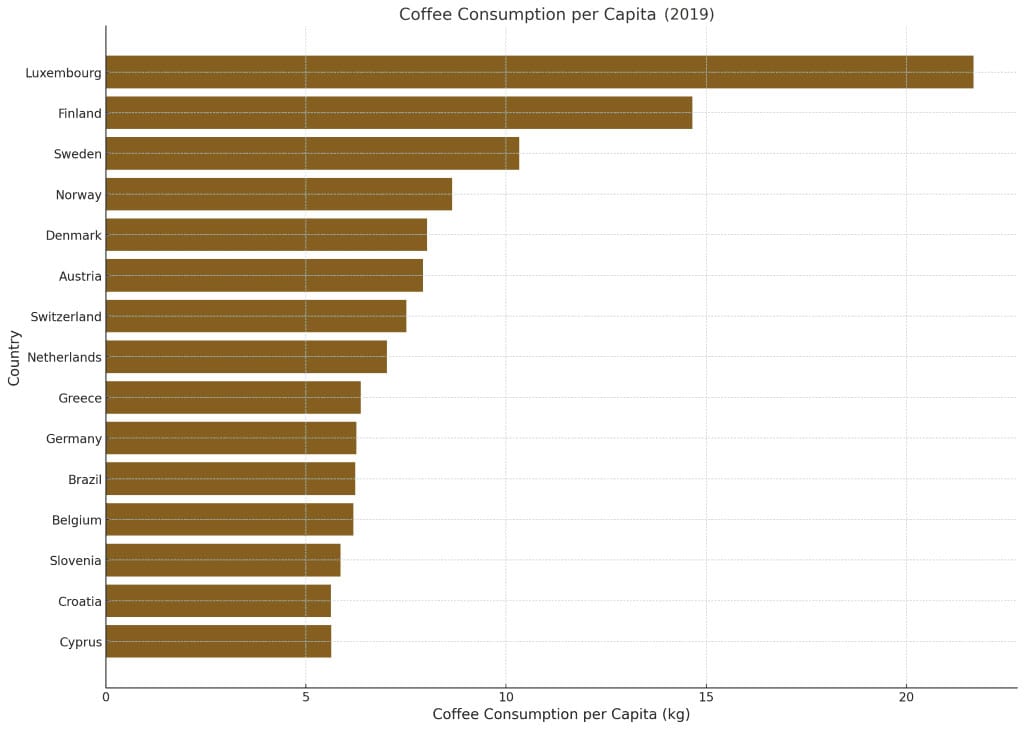
1. Luxembourg: Brewing Up a Coffee Culture
Luxembourg may be a small country, but when it comes to coffee consumption, it truly holds its ground.
With a population of around 634,814 people, they consumed approximately 21.68 kilograms (47.77 pounds) per capita in 2019. In total, the country drank 13.76 million 60kg bags of coffee.
However, this statistic is somewhat flawed. Luxembourg is a small country, as you can see from the population number. What is not so apparent though, is that much of its workforce lives and commutes from abroad. The coffee consumption of the 200,000 daily commuting workers (46% of the workforce) adds to the total coffee consumption data of Luxembourg, which is the reason for the exorbitantly high per-capita consumption statistic.
Correcting for this, the country’s coffee consumption goes down to below 10 kg per person. Still a lot, but not 1st in the world.
2. Finland: Embracing “Kaffeepaussi” as a Way of Life
When it comes to appreciation for quality coffee blends and unique traditions like “kaffeepaussi” (coffee break), Finland doesn’t disappoint.
There’s an unmistakable buzz that permeates this Nordic nation which consumed approximately 14.65 kilograms (32.29 pounds) per person at a 5.5 million population, ranking second around the globe.
3. Sweden: Indulging in the Tradition of “Fika”
With approximately 10.33 kilograms (22.77 pounds) per capita from a 10.3 million population, it’s no surprise that coffee holds a special place in Swedish culture.
Much like the Finns, the Swedes have a tradition called “fika,” which can be best described as taking a break to enjoy coffee and sweet pastries. “Fika” is not just about grabbing a quick cup of Joe; it’s an opportunity for people to socialize and take a moment to relax.
4. Norway: A Nation of Coffee Lovers
In the land of stunning fjords and picturesque landscapes, coffee is a beloved beverage that fuels Norwegians throughout their day.
With a per-person consumption of about 8.65 kilograms (19.07 pounds) from a 5.3 million population in 2019, it’s evident that coffee holds great importance in Norwegian culture.
5. Denmark: Finding “Hygge” in a Cup of Coffee
Denmark may be known for its concept of “hygge,” and coffee plays a central role in creating that cozy atmosphere.
With a consumption rate of approximately 8.03 kilograms (17.73 pounds) per capita and a population of 5.8 million, the Danes have truly embraced their love for this comforting beverage.
6. Austria: Where Coffee Houses Are Cultural Gems
In Austria, particularly in its enchanting capital city Vienna, historic coffee shops offer a glimpse of a bygone era where intellectuals gathered to discuss politics, arts, and philosophy over aromatic cups of coffee.
The caffeinated drink truly captured the hearts of locals and travelers alike, with the country’s consumption at 7.93 kilograms (17.46 pounds) per capita from a population of 8.9 million Austrians.
7. Switzerland: Where Coffee Quality Shines
Nestled in the heart of Europe, Switzerland is known for its cheese and chocolates, but coffee also holds an esteemed place in Swiss culture. For one, the country consumed an average of 7.51 kilograms (16.58 pounds) of coffee per individual in one year with a population of 8.5 million.
So the next time you visit Switzerland, don’t miss the opportunity to satisfy your caffeine cravings while appreciating their breathtaking alpine landscapes or strolling through charming towns like Zurich or Geneva.
8. Netherlands: Savoring “Koffietijd” Throughout the Day
The Netherlands would be highlighted by many connoisseurs who value not only the rich taste shared but a long history of coffee consumption as well.
The Dutch take their “koffietijd” or coffee time seriously, with approximately 7.02 kilograms (15.48 pounds) per capita from a population of around 17.3 million in 2019.
9. Greece: A Vibrant Culture of Coffee
In the sunny Mediterranean paradise of Greece, coffee is more than just a beverage—it’s an essential part of life.
With a consumption rate of approximately 6.37 kilograms (14.05 pounds) per capita from a population of 10.4 million people in 2019, Greeks truly appreciate the flavors and rituals surrounding their coffee.
10. Germany: Embracing Coffee and Cake Tradition
In Germany, the tradition of “Kaffee und Kuchen” (coffee and cake) holds a special place in the hearts of many. The afternoon ritual involves indulging in a freshly brewed cup of coffee paired with delectable cakes or pastries such as Black Forest gateau and apple strudels.
With an 83.1 million population, Germans consumed 6.26 kilograms (13.81 pounds) of coffee per capita in 2019.
11. Brazil: A Coffee Giant
The coffee industry has a lot to owe to Brazil, being its biggest producer, so it’s no surprise that coffee is deeply ingrained in Brazilian culture.
With a population of approximately 211.8 million people, Brazil’s coffee consumers drank an average of 6.23 kilograms (13.74 pounds) each in one year.
12. Belgium: Sipping Coffee with Delightful Treats
Belgian cafes are known for offering not just cozy ambiance but also delightful treats like biscuits or pieces of chocolate alongside your brew.
With a population size of approximately 11.5 million people, Belgians consumed around 6.19 kilograms (13.64 pounds) per capita, showcasing their love for this comforting hot drink paired perfectly with indulgent goodies.
13. Slovenia: Socializing Over Stellar Coffees
Slovenia may be smaller in terms of both population and landmass but has still managed to carve out its own vibrant coffee culture scene. Slovenians view savoring specialty coffees as more than just consuming caffeine; they see it as an opportunity to socialize and connect over quality brews.
With a population of about 2.1 million individuals who consumed roughly 5.86 kilograms (12.92 pounds) per capita in one year, this connection between great conversations accompanied by excellent espresso-based beverages continues thriving.
14. Croatia: Cafes Filled with Caffeine Enthusiasts
Coffee plays an integral role in Croatian social life, and Balkan countries in general. People spend hours enjoying their preferred caffeinated beverage while engaging friends happily amidst bustling cafe atmospheres across the country.
Being a caffeine-loving population of around 4.1 million individuals, Croats consumed approximately 5.62 kilograms (12.41 pounds) per person in 2019.
15. Cyprus: A Mediterranean Coffee Escape
Last but not least, we have Cyprus – a small island nation that boasts a deep-rooted culture of coffee influenced by both Greek and Turkish traditions.
Cypriots take pride in brewing their traditional coffee known as “Cypriot coffee” in a long-handled pot called a “mbriki.”
With a population of approximately 1.2 million people, the consumption per capita comes to about 5.63 kilograms (12.41 pounds) per year.
Does Population Impact How Much Coffee Drinks We Consume?
You might think that the most populated countries are automatically the biggest consumers of coffee around the globe, but the figures show that while it carries a significant influence, the population is only one of the many factors that can drive a nation’s coffee consumption.
The larger countries may have the most coffee drinkers, but the amount that each individual drinker consumes can twist up the narrative. Some smaller countries can exhibit an affinity for their cup of joe at a rate that surpasses that of larger countries.
Take Finland for example, which only has a 5.52 million population, but the Finns’ consumption per capita is a whopping 14.65 kilograms. This may have something to do with their long dark season. A total of 1.34 million 60kg bags were consumed in Finland, which beat Venezuela’s 28.97 million population drinking 2.64 kilograms per person, raking up a total of 1.27 million bags in 2019.
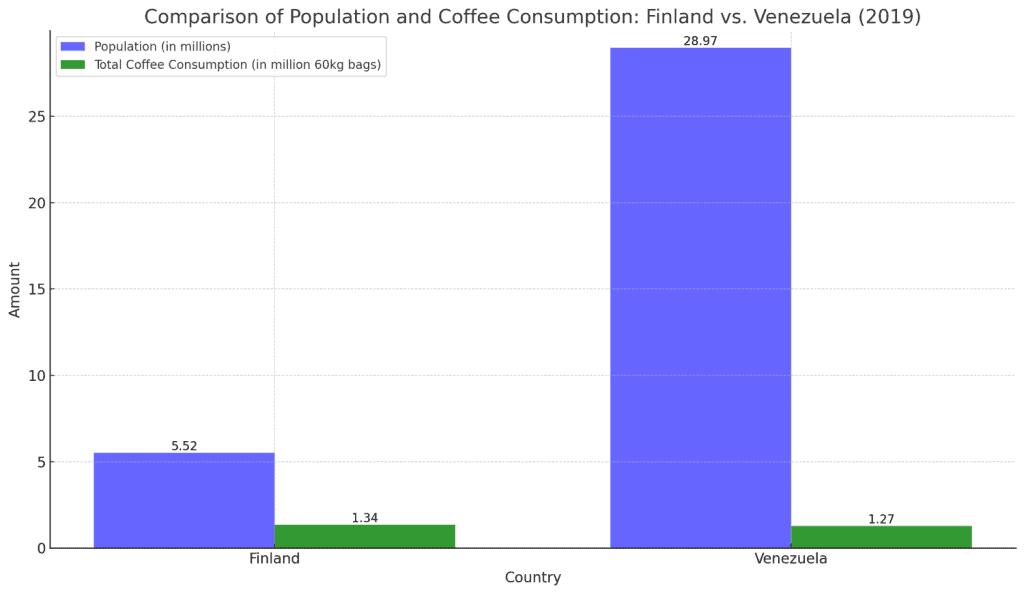
Also, look at the case of China, where coffee consumption is a new phenomenon. As a result of the large population, the per capita coffee consumption is still below 0.10 kg in 2022.
So while population can provide an overarching framework, the intricate tapestry of coffee consumption is woven with threads from various domains, from tradition and lifestyle to economics and accessibility.
Exploring Europe’s Love for Drinking Coffee
Europe’s affair with coffee is a love story that has been brewing for centuries. From the bustling cafés of Vienna to the traditional coffeehouses in Paris, Europeans have long embraced this beloved beverage as an integral part of their daily lives.

As a whole, the European Union actually beat the USA in its consumption of coffee with the two having close population sizes at 342 million and 328 million respectively.
In total, the EU consumed 41.26 million 60kg bags of coffee in 2019, a huge gap from the USA’s 27.31 million.
As a whole, the European Union actually beat the USA in its consumption of coffee.
BigCupOfCoffee.com
After all, the region includes some of the world’s biggest drinkers such as Germany, France, and Italy. The EU countries also dominate the per capita ranking, occupying the majority of the list and sweeping the top three with its countries Luxembourg, Finland, and Sweden.
Diving deeper, European countries are diverse when it comes to their specific cultures regarding coffee. Italy is renowned for its exceptional espresso and patrons standing at bars for a quick shot, while countries like Greece embrace a slower pace, enjoying their cup of joe over conversations with friends.
The “third wave” movement has also become prevalent throughout Scandinavia and Germany, with specialty or artisanal coffee roasters popping up in these countries.
Overall, it’s pretty evident that a passion for coffee is one of the things that the EU nations share.
Interesting Coffee Facts & Statistics Up Till 2025
To give you a better grasp on coffee consumption, here are some interesting coffee statistics to think about:
- 35% of the American population prefers black coffee while the rest of the populace likes to add sugar and/or cream.
- More than 50% of Americans over 18 years of age (about 150 million people) drink coffee every day.
- People around the world consume about 10 billion 60-kilogram bags of coffee in a year.
- Specialty coffee accounts for 8% of the 18 billion dollar US coffee market.
- Women drink as much coffee as men, but women are more concerned about the price than men.
- 41% of coffee drinkers use a drip coffee maker followed by single-cup systems (27%), cold brew (9%), and espresso machines (8%).
- 66% of Americans drink more coffee than other beverages, beating bottled water (60%), tea (47%), tap water (46%), soft drinks (42%), and juice (21%).
- In 2022, the world’s top coffee company Starbucks achieved revenue of $32.91 billion with over 35,000 stores around the world. This is higher than the GDP of countries like Iceland and Bosnia and Herzegovina.
Understanding the world’s coffee habits not only deepens our appreciation for this drink but also allows us to connect with others on a global scale.
So next time you take a sip of your favorite brew, remember that you are partaking in a worldwide phenomenon.
Sources:
- https://www.ico.org/new_historical.asp
- https://data.worldbank.org/indicator/SP.POP.TOTL
- https://ourworldindata.org/grapher/gdp-per-capita-penn-world-table?tab=table
- https://nationalcoffee.blog/2022/09/30/coffee-consumption-reaches-high-in-2022/
- https://www.ncausa.org/newsroom/nca-releases-atlas-of-american-coffee
- https://www.statista.com/statistics/292595/global-coffee-consumption/
- https://www.e-importz.com/coffee-statistics.php
- https://companiesmarketcap.com/starbucks/revenue/


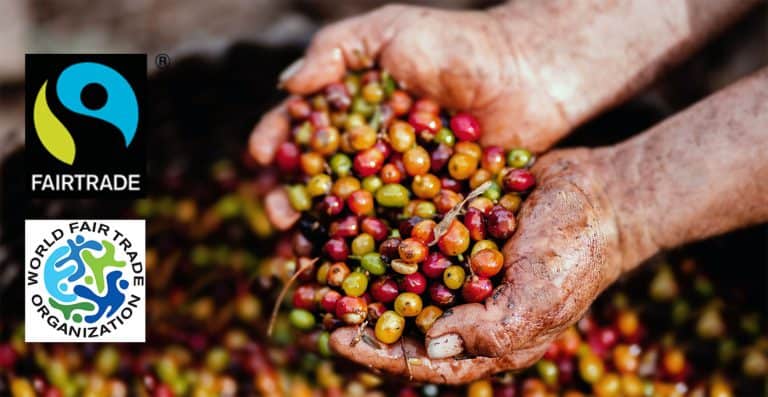
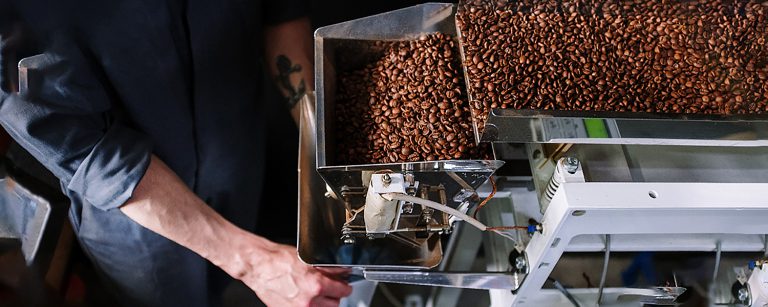
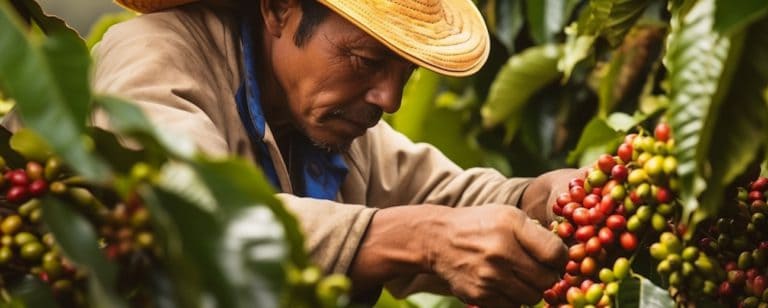



The part about Starbucks dominating the global market is quite spot-on. Having traveled extensively, I’ve noticed that the coffee giant tailors its menu to local tastes, which might explain their ubiquity. Anyone else seen some really unique Starbucks offerings in other countries?
Loved this deep dive into coffee statistics. However, one thing I was hoping to learn more about was the quality of coffee consumed. Are these stats reflective of high-grade beans only, or do they include all qualities? It’d be interesting to compare growth in specialty coffee versus general consumption.
Remarkable stats. Now, I can’t help but wonder, are we seeing a growth in at-home consumption or is the café culture still dominant? It’d be great if the next report could delve into the changing patterns, especially post-pandemic.
The comparison of coffee consumption by country was an interesting read, but what about the impact of population growth on these figures? The article hinted at this connection, but I’d appreciate a more detailed discussion on the subject. How is the coffee landscape adapting to an ever-growing populace?
I found the section on per capita consumption particularly intriguing. Germany’s placement on both lists fascinated me. Could someone explain how coffee culture differs between a country that consumes a lot of coffee overall versus one with high consumption per person?
This article got me thinking about how my coffee habits compare to others around the world. As someone who starts every morning with a latte, I’m curious—what’s the most popular coffee preparation method worldwide? Is it espresso, drip, instant? I’d love to hear what others prefer.
Hailing from the States, I must confess, coffee is my lifeblood. But after reading Tom’s stats, I’m curious how our office’s coffee consumption stacks up against the national average? Does anyone else feel like they’re personally responsible for a sizable chunk of that 27,310 thousand bags?
lol 🙂
Intriguing numbers. Just a slight correction though; the data on Brazil aligns with what’s in the article, but it’s worth noting that there’s a distinction between consumedand produced’. Many tech tools now help analyze these statistics more accurately. It’s amazing to see big data give such granular insight into our coffee habits.
Yes, Brazil is a big producer and also a big consumer.
First of all, I must thank Tom for such an insightful piece. As someone who’s been researching sustainable living, this information prompts a pertinent question about the environmental impact of coffee production and consumption. Does the article touch on this subject, or can fellow readers recommend resources on this topic?
Wow, just wow. I always knew we loved our coffee here in the States, but I didn’t realize we were leading the world in consumption. Thumbs up to the author for compiling these stats.
ow, this was such an eye-opening read! It’s fascinating to see how coffee consumption varies so much around the world. I had no idea countries like Finland were such big coffee drinkers! Do you think cultural factors or climate play a bigger role in these trends? Thanks for compiling these stats – it’s such an interesting topic